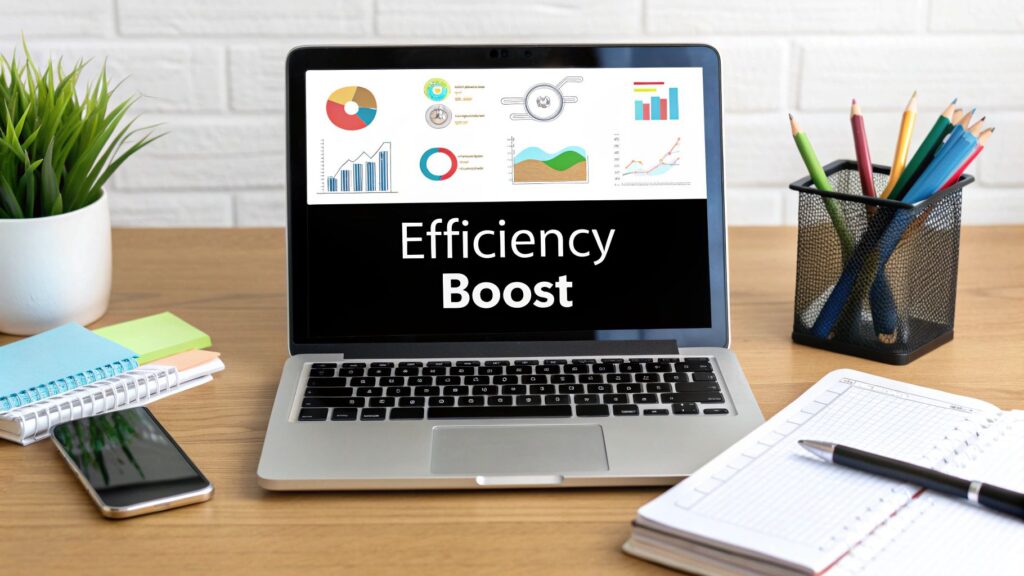Improving your business efficiency isn't some complex, abstract theory. It really boils down to a simple idea: find what slows you down and fix it. It’s about methodically rooting out the bottlenecks, putting repetitive tasks on autopilot, and using technology to work smarter, not just harder. When you focus on these areas, you start to reclaim time and resources that go straight back to your bottom line.
Why Business Efficiency Is Your New Competitive Edge

In today’s UK market, just treading water isn’t an option anymore. "Business efficiency" has stopped being a fluffy corporate buzzword and has become a crucial tool for survival and growth. With fierce competition and a tough economic climate, any business still limping along with clunky, outdated processes is at a serious disadvantage.
The good news? You don't need to tear your entire business apart and start from scratch. It really begins with a shift in mindset—a move towards continuous improvement. It’s about building a culture where every single person on your team feels they can challenge the old "that's how we've always done it" mentality and suggest a better way forward.
Building a Foundation for Smarter Operations
To kick things off, you need to understand where to focus your energy for the biggest impact. Every business, whether it's a local plumbing firm or a fast-growing online shop, rests on three core pillars. Nailing these is where the magic happens.
Before diving into the specifics, let's look at the foundational areas where UK businesses can achieve the most significant efficiency improvements.
The Core Pillars of Business Efficiency
| Pillar | Key Focus Area | Expected Outcome |
|---|---|---|
| People | Skills, motivation, and clear communication channels. | An engaged team that understands their roles and collaborates effectively. |
| Processes | The established workflows for every task, from sales to delivery. | Smoother operations with fewer errors, delays, and wasted effort. |
| Technology | The tools used to support your team and automate work. | Increased productivity, better data insights, and reduced manual labour. |
Getting these three elements in sync is what truly sets a highly efficient business apart from the rest.
The core principle is simple: An efficient business isn't one that works harder, but one where every action has a clear purpose and minimal waste. It's about achieving more with the same—or fewer—resources.
This way of thinking is really taking hold across the UK. Confidence among business leaders is often what gives them the push to invest in improvement. In fact, a recent 'State of UK Business 2025' survey found that 83% of leaders are confident about their outlook for the year ahead. This optimism is a clear sign that businesses are ready to invest in new equipment, digital tools, and employee skills to get more productive. You can explore the full survey to see how this confidence is shaping business plans.
This guide is designed to be your practical roadmap, not just a bunch of theory. We'll walk through concrete steps you can take to spot the hidden drags on your productivity, use smart tech well, and make changes that deliver real, measurable results.
Finding and Fixing Your Hidden Workflow Bottlenecks

It’s an old saying, but it holds true: you can't fix what you can't see. Often, the biggest drags on your business’s efficiency aren’t obvious disasters. They're the silent problems hiding in plain sight—the daily routines and unquestioned processes that have just become "the way things are done."
To get more efficient, you have to become a detective in your own company. Your mission is to uncover the friction points that quietly slow everything down.
So, how do you do it? Forget guesswork. The first step is to make your workflows visible. This doesn't mean you need expensive, complicated software. Honestly, it can be as simple as grabbing a whiteboard and a pack of sticky notes. When you physically map out a process—from the moment a new customer calls to the final invoice being paid—you start to see exactly where things get stuck.
Get a Clear View of Your Operations
One of the most powerful things I've seen businesses do is process mapping. It’s just a way of outlining every single action, decision, and handover in a workflow. Once it’s all laid out in front of you, you'll be amazed at how many redundant steps and unnecessary back-and-forths you can spot.
Another great technique is a ‘day-in-the-life’ exercise. Try shadowing a team member for a full day, or even just tracking your own activities with ruthless honesty. Note down every single task. This is a brilliant way to reveal the true time-sinks and constant interruptions that kill productivity.
I worked with a small marketing agency in Manchester that was constantly battling deadlines. By mapping their project workflow, they found the bottleneck wasn't the creative work at all. It was their chaotic client feedback loop. Emails were getting lost, feedback was coming in from multiple people at once, and there was no single source of truth for revisions. They were stuck in a cycle of rework.
A workflow bottleneck is any point in a process where work piles up faster than it can be handled. It creates a delay that ripples through the entire chain of events. Naming it is the first real step toward a major efficiency boost.
This isn't just about individual businesses, either. It reflects a wider focus on improving business efficiency across the UK, especially when you look at regional productivity. ONS data shows that while London and the South East have historically led the way, regions like the North West and Northern Ireland have seen significant productivity growth since 2019. It just goes to show how targeted improvements, like fixing operational bottlenecks, are vital for lifting performance. You can discover more about UK regional productivity insights to see how these local fixes contribute to the bigger picture.
Ask the Right Questions to Find Bottlenecks
Once you’ve got that visual map of your process, it's time to put on your detective hat again and start asking some hard questions. This is how you pinpoint the exact spots that are ripe for improvement.
Look for the answers to these critical questions:
- Where do tasks wait the longest? Find those stages where work just sits idle before it gets passed on.
- Which steps lead to the most rework? If you're constantly making corrections, it’s a massive red flag for a flawed process or unclear instructions.
- What generates the most complaints? Listen to your team and your customers. Their frustrations are often signposts pointing directly to a bottleneck.
- Are there any steps that add zero value? Challenge everything. Does this task really need to exist? Be ruthless.
By systematically digging into these questions, you stop feeling vaguely "inefficient" and start building a concrete list of problems you can actually solve. That clarity is what turns the overwhelming idea of "improving business efficiency" into a series of small, manageable tasks.
Using Automation to Reclaim Your Team's Time
Once you’ve pinpointed where your workflow is getting gummed up, the next move is to clear those blockages. Automation is your best friend here, a secret weapon that can win back countless hours for your team every single week.
The best part? We're not talking about some overly complex, expensive system that needs a dedicated IT team to run. This is about practical, accessible automation that any small business can put to work, handling those repetitive, rule-based tasks that sap energy and kill focus.
Starting with the Low-Hanging Fruit
Think about the daily grind. So much of it is predictable, manual work that follows a clear set of rules. Automating these tasks is genuinely the easiest way to see a jump in your business efficiency, often overnight. You can start small and still get a big win.
Here are a few classic areas where you can start your automation journey:
- Customer Interactions: Think about setting up smart email sequences that automatically welcome new clients, confirm their orders, or send out shipping updates. Even a simple chatbot on your website can handle common questions 24/7, freeing up your people to tackle the trickier customer problems that require a human touch.
- Internal Tasks: Why is a team member still manually typing data from a form into a spreadsheet? There are tools that do this instantly. The same goes for pulling a standard weekly sales report—that’s a perfect candidate for an automated process.
Imagine an online shop selling handmade crafts. They could automate the entire post-purchase conversation. An email goes out to confirm the order, another fires off when the package ships, and a final one follows up a week later to ask for a review. That simple workflow saves hours and guarantees no customer ever falls through the cracks.
Automation isn't about replacing people. It's about freeing them from robotic work so they can focus on what humans do best: solving problems, being creative, and building real relationships with customers.
Centralising Communications with a Business Number
Another powerful automation tactic is to centralise how customers get in touch. Instead of calls ringing personal mobiles at all hours, a dedicated virtual number from a service like Business Numbers Direct acts as a single, professional hub.
From there, you can set up automated away messages for after-hours enquiries or fire off quick replies to common questions sent via WhatsApp Business. It’s a simple change that ensures every client gets a prompt, professional response, even when you're swamped.
This is where your data comes into play, helping you decide which processes to automate first for the biggest impact.

By digging into the data on where your team spends most of its time on repetitive work, you can prioritise your automation efforts. The whole point is to spot those time-draining patterns and pick the right tools to tackle those specific activities head-on.
Choosing Technology That Actually Solves Problems
The right piece of technology should feel like a superpower for your business, not just another complicated problem to solve. So many businesses fall into the trap of adopting new software just for the sake of it, only to find it actually creates more work. The real secret to boosting efficiency with tech is to be incredibly deliberate.
Instead of chasing the latest shiny object, start with the bottlenecks you found in your workflow analysis. What specific headache are you trying to fix? Is it chaotic client communication? Maybe it's the hours wasted on manual invoicing? Always lead with the problem, not the tool. This focus ensures you’re investing in a genuine solution, not just a subscription.
A Framework for Smart Tech Decisions
Before you even glance at a pricing page, you need a quick mental filter for any potential tool. This isn’t about building a massive spreadsheet; it’s about asking a few critical questions to avoid future pain. A rushed decision now can easily lead to months of frustration for you and your team.
Think about these key factors:
- Integration: How well will this new tool play with your existing systems? If your new project management app can't talk to your invoicing software, you’ve just created a new, tedious data entry task. Real efficiency comes from a connected tech stack.
- True Cost: The monthly fee is just the beginning. You have to factor in the time and resources for training your team and the very real possibility of a temporary productivity dip while everyone adjusts.
- User Experience: If a piece of software is clunky and a pain to use, your team will find creative ways to avoid it. The best tools feel intuitive and don't require a manual the size of a phone book.
Remember, the goal of technology is to reduce friction, not add another layer of complexity. If a tool doesn't make a specific task simpler, faster, or more accurate, it's not the right fit.
This is especially vital for small and medium-sized enterprises (SMEs), which are the true engine room of the UK economy. In early 2024, an incredible 99.9% of the 5.5 million private sector businesses were SMEs. Improving business efficiency on a national scale really depends on these businesses getting the resources they need to compete and grow. You can discover more UK business statistics to get a sense of the sheer scale and impact of SME performance.
Matching Tools to Common Bottlenecks
To help connect the dots between problems and solutions, let's look at some common business inefficiencies and the types of technology specifically built to tackle them. This isn't an exhaustive list, of course, but it’s a solid starting point for any UK SME looking to make a smart investment.
Choosing the right category of software is the first step. Think of it like picking the right tool from a toolbox – you wouldn't use a hammer to turn a screw. This table breaks down some common tech solutions for frequent business headaches.
Technology Solutions for Common Inefficiencies
| Technology Type | Solves Problem Of | Ideal For | Example Tools |
|---|---|---|---|
| Project Management | Disorganised tasks, missed deadlines, poor team collaboration. | Agencies, consultants, and any business running projects with multiple steps. | Trello, Asana, Monday.com |
| CRM | Lost customer details, inconsistent follow-ups, messy sales pipeline. | Sales-focused businesses, service providers, e-commerce stores. | HubSpot, Zoho, Pipedrive |
| Accounting Software | Manual invoicing, messy expense tracking, poor cash flow visibility. | Virtually all businesses, especially freelancers and small companies. | Xero, QuickBooks, FreeAgent |
| Communication Hub | Missed client calls, mixing personal and business messages. | Service-based professionals, e-commerce, anyone needing a professional front. | Business Numbers Direct |
Hopefully, seeing it laid out like this helps you pinpoint exactly what kind of solution would have the biggest impact on your own day-to-day operations. It all comes back to identifying your specific problem first.
Making Continuous Improvement Part of Your Culture
Getting efficient isn’t a one-and-done project. Once you’ve made some headway, the real challenge is making sure you don't slide back into old habits. The most successful businesses I’ve seen are the ones that treat efficiency as a constant cycle, not just a fix for a current problem. This last part is all about weaving that mindset into your company’s DNA, so looking for ways to improve becomes second nature to everyone.
This means shifting from vague ambitions to concrete, measurable goals. Real, lasting change happens when you create a rhythm: find a problem, try a solution, measure the result, and then tweak your approach. It’s the small, consistent improvements that really add up over time.
Set KPIs That Actually Mean Something
You've probably heard it a thousand times, but you can't improve what you don't measure. The first step here is to set up Key Performance Indicators (KPIs) that directly link to the efficiency goals you’ve set. Forget about vanity metrics; your KPIs need to zero in on the specific bottlenecks you're trying to eliminate.
For instance, if late projects were dragging you down, a great KPI would be ‘average project completion time’. If your customer service team was constantly underwater, you could start tracking ‘average first response time’. It’s about being specific.
Here are a few practical examples of efficiency-focused KPIs:
- Cost per new client acquisition: This tells you exactly how much marketing and sales effort it takes to land a new customer.
- Customer ticket resolution time: How long does it really take to solve a customer's issue from start to finish?
- Employee time on manual data entry: This one’s a brilliant way to quantify the hidden cost of tedious, non-essential work.
Choosing the right KPIs gives you a clear baseline. It turns the fuzzy idea of "getting better" into a hard number that your team can see and actively work on improving.
Create Visual Dashboards for Motivation
Once you have your KPIs, for goodness sake, don’t bury them in a spreadsheet that only you can understand. Data is only powerful when it’s visible and dead simple for the whole team to digest. The answer is to create simple, visual dashboards that show your key metrics in real-time.
A visual dashboard turns abstract numbers into a team scorecard. It builds a sense of shared purpose and even a bit of healthy competition, encouraging everyone to play their part.
You don't need to break the bank on fancy software for this. A shared monitor in the office or a straightforward dashboard built with free online tools can work wonders. When your team sees their actions directly move the needle on a KPI like 'cost per client', they start getting invested. It makes efficiency a team sport rather than just another top-down order from management.
Run Collaborative Process Reviews
The final piece of this puzzle is getting everyone together to talk about what’s happening. You need a regular forum for discussion, so I recommend scheduling periodic process review meetings—maybe monthly or quarterly—to look at the data and chat honestly about what’s working and what’s not.
The secret to making these meetings work is to keep them collaborative and focused on solutions. This is absolutely not the time for pointing fingers if a metric has dipped. Instead, it's about asking productive questions together: "Why did our project completion time slip last month? What got in the way? What's one small thing we can try differently this month to get it back on track?"
By building this kind of open, blame-free feedback loop, you empower your team to become true partners in improving business efficiency. After all, they’re the ones doing the work day in and day out, and their insights are gold. This continuous cycle—measure, visualise, discuss, repeat—is what transforms a one-off efficiency push into a powerful, permanent part of how you do business.
Frequently Asked Questions About Business Efficiency
Even with the best-laid plans, questions are bound to pop up once you start tweaking how your business runs. Improving efficiency is a journey, not a one-off task, and hitting a few bumps or feeling uncertain about the next move is completely normal.
To help you push forward with confidence, we've put together some of the most common questions we hear from business owners just like you. Here are some straightforward answers to help you handle the practical side of making your operations run like a well-oiled machine.
Where Should a Small Business Start with Improving Efficiency?
For a small business, the smartest move is to go for the ‘low-hanging fruit’. I’m talking about those small, repetitive tasks that quietly steal a surprising amount of time from your day. Don't try to change everything at once; that’s a recipe for chaos. This focused approach builds momentum and shows your team the real value of these changes without overwhelming anyone.
Start by simply observing your team's daily activities for a week. Keep an eye out for jobs like:
- Manually typing customer details into a spreadsheet.
- Sending the same welcome email time and time again.
- Individually chasing up every overdue invoice.
These are prime candidates for automation with simple, affordable tools. Just pick one or two of these processes, improve them, measure the difference it makes, and then you’re ready to tackle the next one.
How Do I Get My Team On Board with New Processes?
Getting your team to buy in is absolutely crucial. Without their support, even the most brilliant ideas are dead in the water. The secret? You need to frame any changes as a way to make their jobs easier and more fulfilling, not as an attempt to micromanage them.
The best way to do this is to involve them right from the start. Ask them directly: what are your biggest daily frustrations? What tasks waste most of your time? When you introduce a new tool or process, be crystal clear about the ‘why’ behind it. Explain how it will cut down on tedious work and free them up to focus on the more interesting parts of their job—the stuff that actually requires their skills.
When your team sees their feedback is genuinely valued and the changes actually help them, they're far more likely to get on board. Proper training and being genuinely open to their suggestions aren't optional; they're essential.
How Often Should We Review Our Business Processes?
There's no single magic number here, but a good rule of thumb is to carry out a formal process review every quarter. This is frequent enough to spot problems before they become bad habits but not so often that it feels like constant, disruptive change.
Of course, for more critical or fast-moving parts of your business—like a new sales funnel or a customer support workflow—you might want to check in monthly. The real aim is to build a culture where improving business efficiency is an ongoing, open conversation, not a dreaded annual meeting. Encourage your team to flag issues as soon as they see them, rather than waiting for a formal review.
Ready to take the first simple step towards better efficiency? With Business Numbers Direct, you can separate your personal and business communications in under five minutes, creating a more professional image and automating customer responses. Get your dedicated WhatsApp Business number today and see how a small change can make a big difference.




